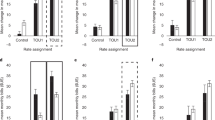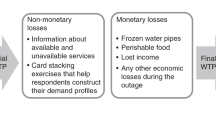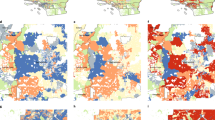Abstract
Demand-side response (DSR) measures are critical to integrating variable renewable generation into electric grids. Time-of-use rates (TOU) are a common DSR mechanism that seeks to shift electricity use to low-demand times using financial instruments. However, consumers generally have a poor understanding of their electricity use and bills, raising questions about the extent to which TOU participation is driven by perceptions of savings versus actual savings. We find that among 8,702 residents who opted into a pilot TOU programme, the TOU treatment decreases on-peak use compared to a control group, but this effect is small. Perceived savings is the strongest predictor of intent to remain on TOU, over and above actual savings, even though it is only weakly related to actual changes in bills and usage. Residents may thus join DSR programmes based on perceived savings without achieving actual monetary or energy use savings, which may undermine the goals of these programmes.
This is a preview of subscription content, access via your institution
Access options
Access Nature and 54 other Nature Portfolio journals
Get Nature+, our best-value online-access subscription
$29.99 / 30 days
cancel any time
Subscribe to this journal
Receive 12 digital issues and online access to articles
$119.00 per year
only $9.92 per issue
Buy this article
- Purchase on Springer Link
- Instant access to full article PDF
Prices may be subject to local taxes which are calculated during checkout



Similar content being viewed by others
Data availability
The processed or aggregated data that support the plots within this paper and other findings of this study are available from the corresponding author upon reasonable request.
References
Denholm, P. & Hand, M. Grid flexibility and storage required to achieve very high penetration of variable renewable electricity. Energy Policy 39, 1817–1830 (2011).
International Energy Agency Electricity Information 2017 (OECD, 2017); https://doi.org/10.1787/electricity-2017-en
Faruqui, A. & Sergici, S. Household response to dynamic pricing of electricity: a survey of 15 experiments. J. Regul. Econ. 38, 193–225 (2010).
Torriti, J. Price-based demand side management: assessing the impacts of time-of-use tariffs on residential electricity demand and peak shifting in Northern Italy. Energy 44, 576–583 (2012).
Faruqui, A. & Malko, J. R. The residential demand for electricity by time-of-use: A survey of twelve experiments with peak load pricing. Energy 8, 781–795 (1983).
Di Cosmo, V. & O’Hora, D. Nudging electricity consumption using TOU pricing and feedback: evidence from Irish households. J. Econ. Psychol. 61, 1–14 (2017).
Woo, C. K., Li, R., Shiu, A. & Horowitz, I. Residential winter kWh responsiveness under optional time-varying pricing in British Columbia. Appl. Energy 108, 288–297 (2013).
Hargreaves, T., Nye, M. & Burgess, J. Making energy visible: A qualitative field study of how householders interact with feedback from smart energy monitors. Energy Policy 38, 6111–6119 (2010).
Nicholls, L. & Strengers, Y. Peak demand and the ‘family peak’ period in Australia: Understanding practice (in)flexibility in households with children. Energy Res. Soc. Sci. 9, 116–124 (2015).
Delmas, M. A., Fischlein, M. & Asensio, O. I. Information strategies and energy conservation behavior: A meta-analysis of experimental studies from 1975 to 2012. Energy Policy 61, 729–739 (2013).
Attari, S. Z., DeKay, M. L., Davidson, C. I. & Bruine de Bruin, W. Public perceptions of energy consumption and savings. Proc. Natl Acad. Sci. USA 107, 16054–16059 (2010).
Faruqui, A. & George, S. Quantifying customer response to dynamic pricing. Electr. J. 18, 53–63 (2005).
Mostafa Baladi, S., Herriges, J. A. & Sweeney, T. J. Residential response to voluntary time-of-use electricity rates. Resour. Energy Econ. 20, 225–244 (1998).
Train, K. & Mehrez, G. Optional time-of-use prices for electricity: econometric analysis of surplus and Pareto impacts. Rand. J. Econ. 25, 263 (1994).
Nicolson, M., Huebner, G. & Shipworth, D. Are consumers willing to switch to smart time of use electricity tariffs? The importance of loss-aversion and electric vehicle ownership. Energy Res. Soc. Sci. 23, 82–96 (2017).
Schley, D. R. & DeKay, M. L. Cognitive accessibility in judgments of household energy consumption. J. Environ. Psychol. 43, 30–41 (2015).
Brounen, D., Kok, N. & Quigley, J. M. Energy literacy, awareness, and conservation behavior of residential households. Energy Econ. 38, 42–50 (2013).
Attari, S. Z. Perceptions of water use. Proc. Natl Acad. Sci. USA 111, 5129–5134 (2014).
Iwata, K., Katayama, H. & Arimura, T. H. Do households misperceive the benefits of energy-saving actions? Evidence from a Japanese household survey. Energy Sustain. Dev. 25, 27–33 (2015).
Ericson, T. Households’ self-selection of dynamic electricity tariffs. Appl. Energy 88, 2541–2547 (2011).
Caves, D. W., Herriges, J. A. & Kuester, K. A. Load shifting under voluntary residential time-of-use rates. Energy J. 10, 83–99 (1989).
Hargreaves, T., Nye, M. & Burgess, J. Keeping energy visible? Exploring how householders interact with feedback from smart energy monitors in the longer term. Energy Policy 52, 126–134 (2013).
Angrist, J. D. & Pischke, J.-S. Mostly Harmless Econometerics: An Empiricist’s Companion (Princeton Univ. Press, Princeton, 2009).
Tofighi, D. & MacKinnon, D. P. RMediation: An R package for mediation analysis confidence intervals. Behav. Res. Methods. 43, 692–700 (2011).
Ahmadi-Karvigh, S., Ghahramani, A., Becerik-Gerber, B. & Soibelman, L. Real-time activity recognition for energy efficiency in buildings. Appl. Energy 211, 146–160 (2018).
Kessels, K. et al. Fostering residential demand response through dynamic pricing schemes: a behavioural review of smart grid pilots in Europe. Sustainability 8, 929 (2016).
Lynham, J., Nitta, K., Saijo, T. & Tarui, N. Why does real-time information reduce energy consumption? Energy Econ. 54, 173–181 (2016).
Faruqui, A., Sergici, S. & Sharif, A. The impact of informational feedback on energy consumption—A survey of the experimental evidence. Energy 35, 1598–1608 (2010).
Dejoy, D. M. The optimism bias and traffic accident risk perception. Accid. Anal. Prev. 21, 333–340 (1989).
Sheeran, P. Intention—behavior relations: a conceptual and empirical review. Eur. Rev. Soc. Psychol. 12, 1–36 (2002).
Borenstein, S. The long-run efficiency of real-time electricity pricing. Energy J. 26, 93–116 (2005).
Fabrigar, L. R. & Wegener, D. T. Exploratory Factor Analysis (Oxford Univ. Press, Oxford, 2011).
Osborne, J. & Costello, A. B. Best practices in exploratory factor analysis: four recommendations for getting the most from your analysis. Pan Pacific Manag. Rev. 12, 131–146 (2009).
Neter, J., Wasserman, W. & Kutner, M. H. Applied Linear Regression Models (Irwin, Homewood, 1989).
Miles, J. & Shevlin, M. Applying Regression and Correlation: A Guide for Students and Researchers (Sage, London, 2001).
Baron, R. M. & Kenny, D. A. The moderator-mediator variable distinction in social psychological research: conceptual, strategic, and statistical considerations. J. Pers. Soc. Psychol. 51, 1173–1182 (1986).
MacKinnon, D. P., Lockwood, C. M., Hoffman, J. M., West, S. G. & Sheets, V. A comparison of methods to test mediation and other intervening variable effects. Psychol. Methods 7, 83–104 (2002).
Hayes, A. F. Introduction to Mediation, Moderation, and Conditional Process Analysis (The Guilford Press, New York, 2013).
Cameron, A. C. & Trivedi, P. K. Microeconometrics using Stata (Stata Press, College Station, 2009).
Yuan, Y. & MacKinnon, D. P. Robust mediation analysis based on median regression. Psychol. Methods 19, 1–20 (2014).
Acknowledgements
The authors would like to thank their utility partner for furnishing the data, D. Mazmanian for extensive advice and J. McPartlan for considerable time invested in data management.
Author information
Authors and Affiliations
Contributions
Both authors conceived the paper and designed the research and analysis methods. L.W. performed the analyses and wrote the initial draft of the paper. N.S. reviewed several drafts and made substantial revisions.
Corresponding author
Ethics declarations
Competing interests
The authors declare no competing interests.
Additional information
Publisher’s note: Springer Nature remains neutral with regard to jurisdictional claims in published maps and institutional affiliations.
Supplementary information
Supplementary Information
Supplementary Tables 1–10, Supplementary Figures 1–2, Supplementary Notes, Supplementary References
Rights and permissions
About this article
Cite this article
White, L.V., Sintov, N.D. Inaccurate consumer perceptions of monetary savings in a demand-side response programme predict programme acceptance. Nat Energy 3, 1101–1108 (2018). https://doi.org/10.1038/s41560-018-0285-y
Received:
Accepted:
Published:
Issue Date:
DOI: https://doi.org/10.1038/s41560-018-0285-y
This article is cited by
-
Incentive based emergency demand response effectively reduces peak load during heatwave without harm to vulnerable groups
Nature Communications (2023)
-
Impacts of long-term temperature change and variability on electricity investments
Nature Communications (2021)
-
Matching consumer segments to innovative utility business models
Nature Energy (2021)
-
Challenges and prospects for negawatt trading in light of recent technological developments
Nature Energy (2020)
-
Health and financial impacts of demand-side response measures differ across sociodemographic groups
Nature Energy (2019)



